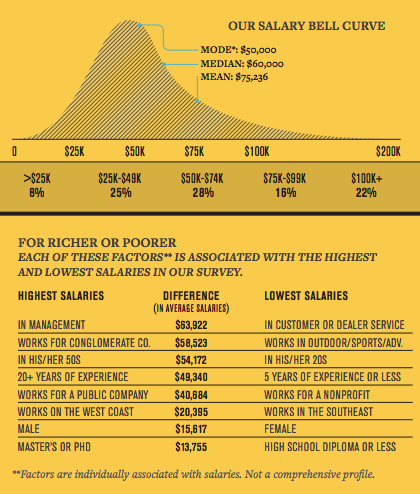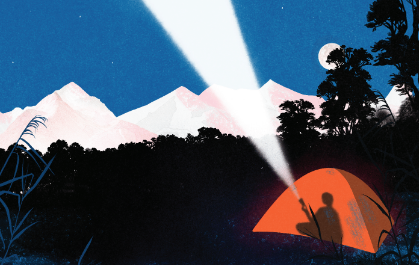Money: like politics, religion, and bodily functions, you’re not supposed to discuss it in polite company. And we get it. How much hard-earned cash your labor brings home can feel like an intensely personal detail, affecting everything about how you work and play.
But when wages are shrouded in secrecy, and job offers include an awkward salary dance where nobody wants to throw out the first number, it’s hard to know if you’re being paid fairly. How can you tell how your paycheck measures up if you don’t know what anybody else is making?
So we asked. Our online salary survey grilled outdoor industry members—from corporate bigwigs to entry-level retail clerks—about their take-home pay, benefits, companies, job types, and much more— and how everyone feels about their paychecks.
Fair pay and job satisfaction start with shining a light on how salary plays out in this industry. Go ahead, break that taboo. Let’s start talking money.
Industry Overview
The Voice’s exclusive outdoor industry salary survey reveals who makes what—and a whole lot more. How do you stack up? Over and over, survey respondents called this a “passion industry” that draws in people who love the outdoors and want to spend their workdays immersed in the culture. Turns out, there’s a lot to love about this industry when it comes to paychecks, too. Though respondents reported salaries ranging from $0 to $200,000, the average overall salary was $75,236—well above the U.S. average of $51,960 for all jobs, according to the Bureau of Labor Statistics. And of our respondents, almost 40 percent make more than $75,000.
But although a majority love their careers, many also reported feeling tension between the benefits of having a “cool job” and the realities of making ends meet. Some of us are struggling. “I jokingly say I’m taking a pay cut to live in paradise, but it’s still not right,” said a retail staffer in California. “Dumpster diving has been a way of life at times just to eat. Try explaining to your parents why you hold a BA in business but can’t afford dinner.”
Others feel their employers take advantage of the very passion that drew them to this business. “Outdoor industry professionals put their heart and soul into highly coveted jobs,” said a manager at a climbing school in Maine who makes well under the average industry wage. “It’s unfortunate that because we love our jobs, we get stuck with smaller salaries.” Some respondents felt that the chance to work in a field close to their hearts was worth the tradeoff: “I have a rich quality of life, regardless of whether my bank account reflects it or not,” said a Colorado rafting company employee. “If you want to get rich, be an investment banker or tech developer,” added the owner of a shoe distribution company. “If you want balance between pay and life, stick with this industry.” For others, it’s not so simple.
“The company is wonderful and treats me well,” said a Nevada respondent who works for a clothing manufacturer.
“Work-life balance is amazing. But I have to have a second job to pay the bills. I can’t feed my family with fleece.”
See “Our Salary Bell Curve,” below, for an overview of outdoor industry paychecks according to our survey.

Highs and Lows
What kind of employees make the most money—and the least? Certain factors turned out to be associated with significantly higher or lower salaries, in some cases by large margins. Some are no surprise: older workers with more experience and/or education tended to make more money, and larger companies with higher earnings paid higher wages. Which corner of the industry you work in also made a sizable difference in take-home pay. On the top end of the spectrum, large conglomerates or parent companies paid, on average, $58,000 more per year than the lowest-tier category, the outdoor/sports/adventure field (which includes outfitters and travel guides). And our survey found a significant pay gap between men and women (see page 87). (Wondering if there’s a pay gap associated with race or ethnicity in this industry? We did too, but we didn’t hear from enough people of color to run a meaningful analysis.) See “For Richer or Poorer,” left, for a breakdown of the significant factors affecting salary.
Where the Money Is: Job Types
If the biggest possible paycheck is your goal, then start climbing the ladder at a larger conglomerate/parent company or shoe manufacturer—on average, those employers pay more than double the amount you’d earn from the industry’s least lucrative fields. Clothing and gear manufacturers, distribution, and sales also end up north of the industry’s average salary. Middle-of-the-pack employers included nonprofits, public relations, media, and the self-employed (a catchall category that ranged from wholesale sales positions to gear designers to freelance writers), all of which landed in the low $60Ks to low $70Ks. The bottom rung of our salary ladder belonged to retailers and the outdoor/sports/adventure category, with average wages in the $50K range. See “Earning Potential,” right, for more.
Across all company types, people in management netted the highest average annual salary, $98,936, followed closely by the product/engineering/R&D/manufacturer product distribution department. Jobs in sales and marketing, PR, design, and writing came next, in the high $60K to low $70K range. Another step down you’ll find gigs in operations, logistics, information technology, human resources and purchasing/finance (high $50K to low $60K range). Customer and dealer service positions bring in the lowest wages at $35,014.
Who’s the Boss? Company Types
Whoever is issuing your paychecks makes a big difference in salary, too. Annual take-home pay, on average, is significantly higher at publicly owned companies than anywhere else: $93,040. Privately owned companies, on the other hand, come in with an average of $73,606. Nonprofits pay significantly less: $52,356.
Companies with more than 250 employees pay about $17K more per year, on average, than those with one to four employees. If your employer hauls in more than $1 billion in annual revenue, that’s worth about $34K more in your salary than employers that make less than $5 million.
Paying Your Dues: Experience
Like anywhere else, patience pays off in the outdoor industry. Though the average salary across job types for people in their 20s is $45,018, our survey found that by their 40s, the average worker doubles her compensation (to $90,134). Salary peaks in the 50s at $99,190. The same pattern holds true for an employee’s years of experience, with average salaries doubling after 20 years of work.
Sticking with the same company also pays off over time, though not necessarily with steady increases. Our survey found that within one employer, salaries rise after about two years on the job, then continue to increase moderately in years three and four. After five years, average salaries finally jumped by about $22K; another 10 to 19 years of commitment to the same place was worth another $11K.
Getting Schooled: Education
Was that degree worth it? While how much your educational attainment matters will vary depending on specific fields and job responsibilities, in general, those with higher degrees brought home higher pay—but the difference didn’t become significant until you hit a master’s degree or PhD. Those with advanced degrees earned an average of about $8,600 more per year than those with a bachelor’s degree, and $13,700 more than those with a high school diploma or less.
The Rich Get Richer: Benefits
Compensation is about a lot more than just the zeroes on your paycheck: benefits like employer-subsidized health insurance, paid vacation, stock options, bonuses, and flexible work structures are worth plenty, too. Most respondents get health insurance and 401(k) matching from their employers; the option to work from home or bring a dog to the office were also popular benefits. Perks like a gym membership, unlimited vacation, and tuition reimbursement went to the lucky few. Employer-supplied or –subsidized childcare was the money issue the rarest benefit of all, with just 18 people (1 percent of the total) reporting it.
And the people who snag extra compensation on top of their regular wages tend to already be bringing in top dollar. Employees with stock options (6 percent of the total) have an average salary of $106,616, and those who receive 401(k) matching funds and performance-review or sales bonuses are generally already in the $80K range. The highest-paying company types, parent/conglomerate companies and shoe manufacturers, also paid out the most perks.
Overall, 36 percent of employees get no additional money on top of their wages, while 57 percent take home at least $1,000 per year in extra compensation (12 percent get $20K or more).
Gimme More: Job and Salary satisfaction
The good news: most of us love our jobs, no matter what kind of money we’re making. A full 87 percent of us are at least moderately happy with our careers, with almost half reporting high job satisfaction. And money isn’t everything: interestingly, people who work for conglomerate/parent companies are the least happy with their jobs (19 percent say they’re unsatisfied), even though they make the highest average pay.
And though the outdoor industry pays fairly well compared to the overall U.S. job market, we almost universally agree that we’re at least a little underpaid. Only 16 percent of respondents said they’re happy with their compensation, while nearly three-fourths think they should be making more. Fourteen percent felt extremely underpaid.
Those who said they’re “somewhat” or “extremely” underpaid do make less than the industry average. But if you felt “a little” underpaid or “wish I made more,” take heart: your salary is likely above average. Those who reported feeling that their paychecks were “just right” tended to earn more than $100K.


